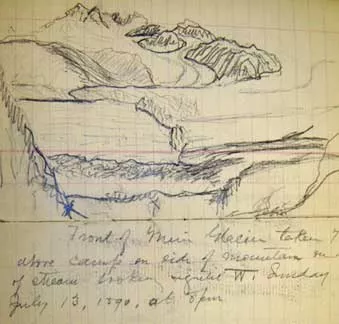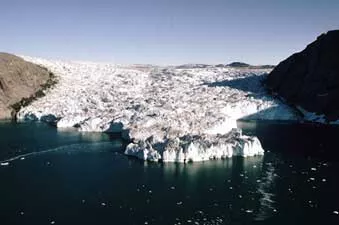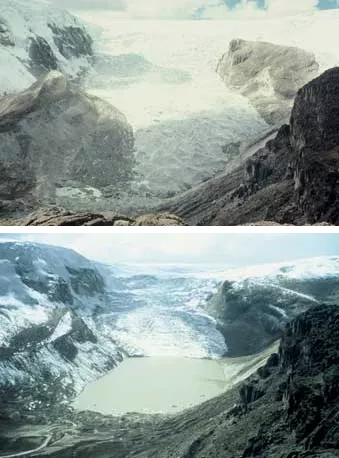By Jane Beitler
With few exceptions, glaciers around the world have retreated over the last century. Some ice caps, glaciers, and shelves have disappeared altogether. Many more are retreating so rapidly that they may vanish within decades. Because glaciers are sensitive to temperature fluctuations, they represent indicators of climate change. The National Snow and Ice Data Center houses an extensive collection of glacier photographs that constitute an important historical record, providing visual evidence of how glaciers have changed over time.
The online Glacier Photograph Collection
The NSIDC Glacier Photograph Collection is a searchable collection of glacier photographs, mostly taken in the Rocky Mountains, the Pacific Northwest, Alaska, and Greenland. Photographs were taken from both the air and the ground. The dates of the photographs range from the mid 1800s to the present day. As of October 2009, more than 12,700 glacier photographs are online. NSIDC's analog holdings of historical glacier photographs, in the form of prints, microfiche, and glass plates, are the foundation of the online collection. The NOAA at NSIDC program has been digitizing the collection, adding more photographs to the online holdings each year.
The analog collection
NSIDC houses hundreds of thousands of glacier photographs in our archives: The American Geophysical Union/American Geographical Society Collection was donated to NSIDC/WDC for Glaciology by William O. Field. Field indexed the photos by region and drainage system. The Harry F. Reid collection includes approximately 600 glass plate negatives and prints, 22 expedition notebooks, and about one cubic foot of manuscript materials, including drafts of Reid's map of Glacier Bay, Alaska. Reid traveled to Glacier Bay in 1890 and 1892 to photograph and map the area. Also included are Reid's photographs of the Alps, taken from 1894 through 1901. The Austin Post aerial photograph collection consists of copies of the Post-Mayo-Krimmel (PMK) Collection. It comprises approximately 100,000 photographs, almost all of which are only available on microfilm at NSIDC. The Greenland photograph collection was donated in the mid-1980s by Captain Ron Kollmeyer of the U.S. Coast Guard (USCG). More than 1,200 color slides of western Greenland glaciers, taken between 1969 and 1980, have been digitized and are now available online
Glacier Photograph Special Collections
Our holdings also include interesting subsets of photographs, highlighted as Special Collections. Repeat Photography of Glaciers This special collection displays photographs of the same glacier, taken from the same vantage point and at the same time of year, but taken many years apart. Repeat photography can reveal dramatic changes in the glacier terminus position, as a glacier either advances or retreats. National Park Service Glacier Survey Reports This special collection highlights glacier photographs taken from original National Park Service (NPS) Glacier Survey reports. Currently in the collection are reports from Rocky Mountain National Park (RMNP) produced between 1932 and 1952. DAHLI IGY Glacier Photographs This special collection is from Alaskan glacier surveys led by William O. Field during the International Geophysical Year 1957-1958.
Analog to digital
NSIDC is digitizing selected analog photographs for online distribution, with the support of the NOAA National Geophysical Data Center, NOAA's Climate Data Modernization Program, and in partnership with HOV Services, Ltd. The goals of this project are as follows:
- Make the photographs better known among the science and glaciological communities.
- Increase image availability.
- Provide the highest-quality digital reproductions.
- Provide proper archival storage.
Because NSIDC lacks resources for storing all our analog glacier photographs under archival quality conditions, some are in danger of deterioration. This gives urgency to our digitization work: allowing researchers to access high-quality digital reproductions of these fragile and rare photographs limits handling of archival images and aids in the preservation of the originals.
Accessing the online collection
The Glacier Photograph Collection has a new Search and Order Web interface. You can search for glaciers by spatial coverage and temporal range as well as by glacier name or by photographer. You also now have the option of running multiple searches before placing an order. To access the new interface, see the Glacier Photograph Collection Web site. For more information about our online or analog holdings, or for appointments to visit us onsite to access the analog holdings, contact NSIDC User Services.


